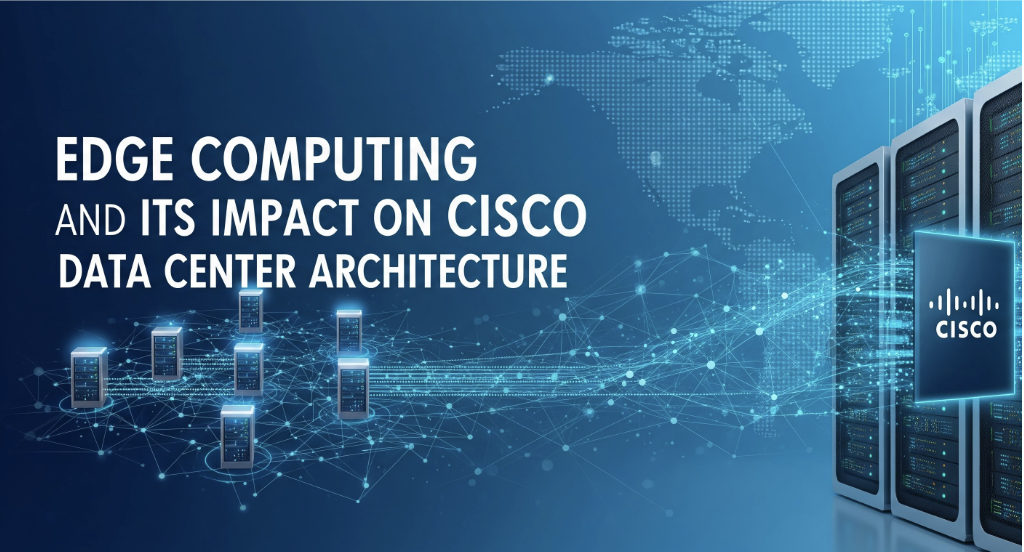Introduction
The rapid growth of connected devices, real-time analytics, and artificial intelligence has given rise to a new computing paradigm — Edge Computing. Unlike traditional centralized data processing models, edge computing brings computation and storage closer to the data source, enabling faster response times and reducing latency. As global industries continue to digitize, Cisco has been at the forefront of reimagining data center architecture to support this distributed model. For networking professionals undergoing CCNP Data Center Training, understanding edge computing’s role in shaping modern infrastructure is becoming an essential skill for career advancement.
Cisco’s data center architecture is evolving to seamlessly integrate edge environments, ensuring that applications and services operate efficiently across distributed networks. This shift is redefining how enterprises design, secure, and manage their digital ecosystems — and mastering it through the CCNP Data Center Certification positions engineers at the center of this transformation.
What Is Edge Computing?
Edge computing is a distributed IT framework that processes data closer to its origin — whether that’s a sensor, IoT device, or local gateway — rather than sending it to a distant centralized data center or cloud. The goal is to minimize latency, reduce bandwidth usage, and enhance real-time decision-making.
For example, in applications like autonomous vehicles, healthcare monitoring, or industrial automation, milliseconds matter. Edge computing enables faster data analysis and response, improving both operational performance and user experience.
Cisco has recognized this shift and adapted its data center technologies to support edge computing’s scalability, flexibility, and performance demands.
How Edge Computing Transforms Cisco Data Center Architecture
1. Distributed Processing Model
Traditional Cisco data centers were designed around centralized computing — where core infrastructure handled storage and processing. Edge computing decentralizes this model by distributing workloads across multiple nodes located closer to the end user.
Cisco’s Application Centric Infrastructure (ACI) and Intersight platforms now enable seamless policy and management integration between core data centers and distributed edge sites. This ensures uniform security, automation, and visibility, even across thousands of endpoints.
2. Integration with Cloud and Hybrid Environments
Modern data centers operate in hybrid environments that combine on-premise infrastructure, public clouds, and edge locations. Cisco’s architecture supports this through ACI Anywhere, which allows policies to extend consistently from data center to cloud to edge.
This integration enables IT teams to deploy workloads flexibly based on performance, compliance, or latency requirements. Cisco’s approach bridges the gap between centralized intelligence and distributed execution — a crucial capability in the era of edge computing.
3. Scalability and Automation
Managing a network that spans multiple edge nodes requires automation at scale. Cisco leverages tools such as Nexus Dashboard, Intersight Cloud Orchestrator, and Cisco NSO (Network Services Orchestrator) to automate provisioning, configuration, and monitoring across distributed environments.
Through these platforms, network operations teams can achieve intent-based management — defining outcomes and allowing Cisco’s systems to automatically implement them across core and edge resources.
4. Enhanced Security Architecture
Edge environments introduce new vulnerabilities since data is processed across multiple locations. Cisco addresses these challenges through Zero Trust Security, micro-segmentation, and identity-based policy enforcement. Security policies created in ACI can be replicated across all connected edge sites, ensuring consistent protection without manual configuration.
Cisco’s Secure Workload (formerly Tetration) further enhances visibility by continuously monitoring traffic patterns between applications, identifying potential threats, and enforcing compliance policies automatically.
The Role of Cisco ACI and Intersight in Edge Enablement
Cisco’s ACI serves as the foundation of its edge-enabled architecture, offering policy-based automation that connects data centers and edge nodes seamlessly. It simplifies operations by translating application requirements into network policies, ensuring consistency across all locations.
Meanwhile, Cisco Intersight provides unified visibility and lifecycle management across distributed environments. It allows administrators to monitor, configure, and update infrastructure components remotely through a cloud-based interface — ideal for managing the geographically dispersed systems that define edge computing.
Together, these solutions make it possible for enterprises to deploy scalable, secure, and automated edge architectures that align perfectly with the principles of modern networking.
Benefits of Integrating Edge Computing with Cisco Data Centers
- Reduced Latency: Real-time processing close to the data source improves responsiveness for time-sensitive applications.
- Improved Reliability: Localized processing ensures that applications can continue running even if cloud connectivity is disrupted.
- Optimized Bandwidth: Only relevant data is transmitted to the core or cloud, lowering bandwidth costs and network congestion.
- Enhanced User Experience: Edge architectures provide faster, more consistent service delivery for global users.
- Greater Efficiency: Automated resource allocation ensures optimal use of computing power across locations.
These benefits underline why edge integration is becoming a strategic priority for businesses and why engineers need to master it as part of their professional toolkit.
Career Relevance for Networking Professionals
For IT professionals, the growing adoption of edge computing presents new opportunities. Engineers who understand how to design, automate, and secure distributed architectures will be in high demand. CCNP Data Center Training provides in-depth exposure to the technologies that enable edge integration — including ACI, Intersight, Nexus switching, and NSO orchestration.
Organizations worldwide are seeking certified Cisco specialists who can ensure seamless connectivity and automation between the data center core and the intelligent edge. As edge computing expands across sectors like healthcare, manufacturing, and telecommunications, the demand for Cisco-trained experts will continue to surge.
Conclusion
Edge computing is reshaping the future of IT infrastructure, driving the need for agile, automated, and intelligent networks. Cisco’s data center architecture — built on platforms like ACI, Intersight, and NSO — provides the tools enterprises need to connect and control a distributed digital world. For professionals eager to stay ahead of this transformation, achieving the CCNP Data Center Certification is a powerful way to build the expertise required to design, secure, and optimize next-generation data centers that operate at the edge of innovation.





Comments